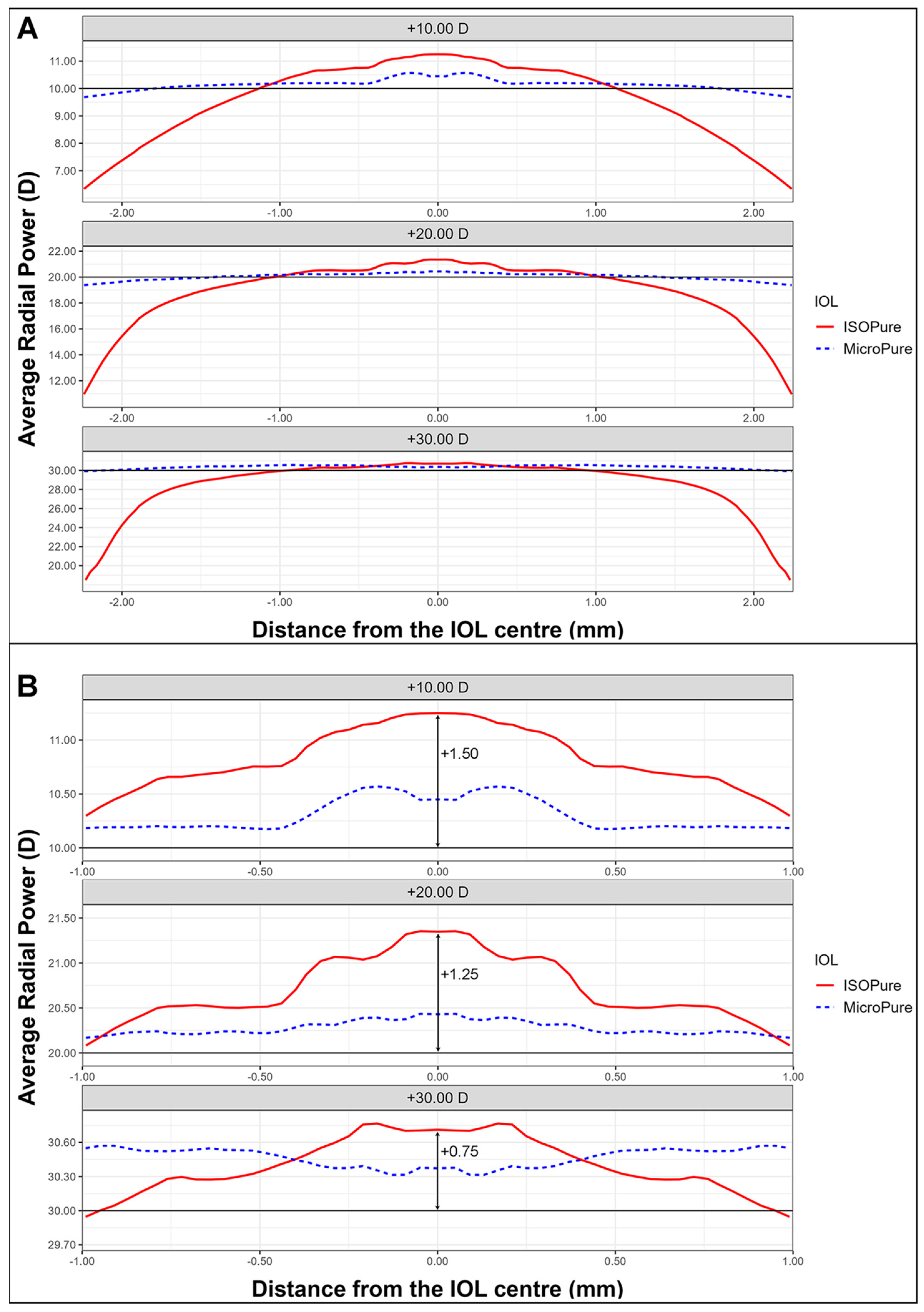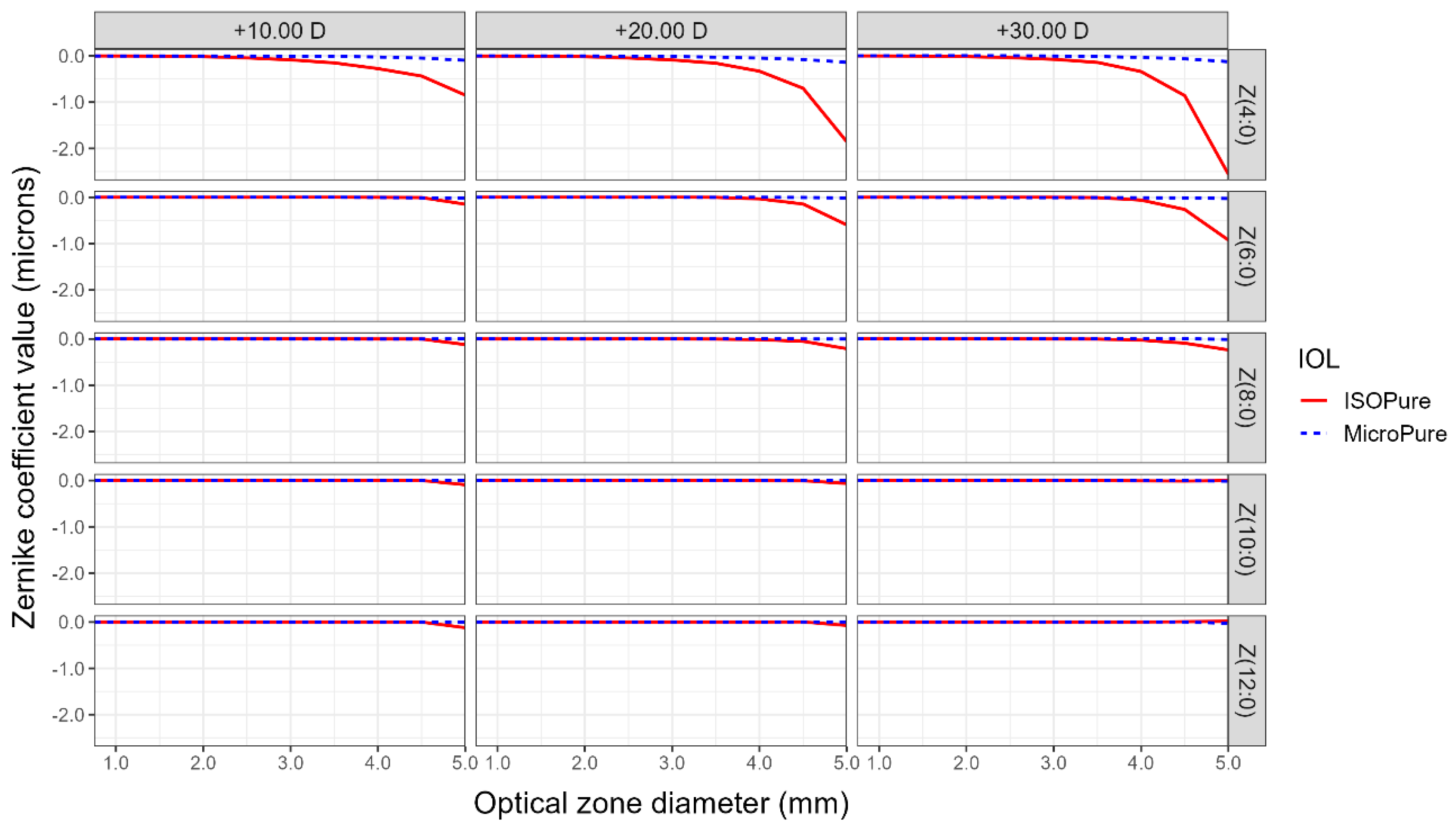Optical and Clinical Outcomes of an Isofocal Intraocular Lens vs. a Monofocal Standard Lens
Abstract
:1. Introduction
2. Materials and Methods
2.1. Optical Bench
2.2. Intraocular Lenses
2.3. Clinical Study
2.4. Data Analysis
3. Results
3.1. Optical Bench
3.2. Clinical Study
4. Discussion
4.1. Optical Bench
4.2. Clinical Study
5. Conclusions
Author Contributions
Funding
Institutional Review Board Statement
Informed Consent Statement
Data Availability Statement
Conflicts of Interest
References
- Fernandez, J.; Rocha-de-Lossada, C.; Zamorano-Martin, F.; Rodriguez-Calvo-de-Mora, M.; Rodriguez-Vallejo, M. Positioning of enhanced monofocal intraocular lenses between conventional monofocal and extended depth of focus lenses: A scoping review. BMC Ophthalmol. 2023, 23, 101. [Google Scholar] [CrossRef] [PubMed]
- Rampat, R.; Gatinel, D. Multifocal and Extended Depth-of-Focus Intraocular Lenses in 2020. Ophthalmology 2021, 128, e164–e185. [Google Scholar] [CrossRef] [PubMed]
- Megiddo-Barnir, E.; Alio, J.L. Latest Development in Extended Depth-of-Focus Intraocular Lenses: An Update. Asia Pac. J. Ophthalmol. 2023, 12, 58–79. [Google Scholar] [CrossRef] [PubMed]
- Fernández Gutiérrez, D.; Barbero Briones, S.; Dorronso Díaz, C.; Marcos Celestino, S. Refractive Multifocal Intraocular Lens with Optimised Optical Quality in a Range of Focus and Method to Produce It. European Patent EP2941222A1, 27 December 2013. [Google Scholar]
- Alonso, J.; Gómez-Pedrero, J.A.; Quiroga, J.A. Modern Ophthalmic Optics, 1st ed.; Cambridge University Press: Cambridge, UK, 2019; p. 36. [Google Scholar] [CrossRef]
- Bova, A.; Vita, S. Clinical and Aberrometric Evaluation of a New Monofocal IOL with Intermediate Vision Improvement. J. Ophthalmol. 2022, 2022, 4119698. [Google Scholar] [CrossRef]
- Alarcon, A.; Canovas, C.; Koopman, B.; Pande, M.V.; Koch, D.D.; Piers, P. Optical bench evaluation of the effect of pupil size in new generation monofocal intraocular lenses. BMC Ophthalmol. 2023, 23, 112. [Google Scholar] [CrossRef] [PubMed]
- Joannes, L.; Dubois, F.; Legros, J.-C. Phase-shifting Schlieren: High-resolution quantitative schlieren that uses the phase-shifting technique principle. Appl. Opt. 2003, 42, 5046–5053. [Google Scholar] [CrossRef] [PubMed]
- de Groot, P. Phase Shifting Interferometry. In Optical Measurements of Surface Topography; Leach, R., Ed.; Springer: Berlin/Heidelberg, Germany, 2011; pp. 167–186. [Google Scholar] [CrossRef]
- Joannes, L.; Jacot, M.; Hutsebaut, X.; Dubois, X. NIMO TR1504 Software User Guide, Version 2.17.3; Lambda-X: Nivelles, Belgium, 2019.
- Vargas, J.; Gómez-Pedrero, J.A.; Alonso, J.; Quiroga, J.A. Deflectometric method for the measurement of user power for ophthalmic lenses. Appl. Opt. 2010, 49, 5125–5132. [Google Scholar] [CrossRef] [PubMed]
- Wade, N.; Swanston, M. Visual Perception: An Introduction, 3rd ed.; Psychology Press: London, UK, 2012. [Google Scholar] [CrossRef]
- Gómez-Pedrero, J.; Albarrán, C.; Garcia-Montero, M.; Garzón, N.; Fernández-González, V. Influence of instrumental factors in the measurement of power profiles of intraocular lenses with a commercial deflectometer. Appl. Sci. 2023, 13, 9882. [Google Scholar] [CrossRef]
- R Core Team. R: A Language and Environment for Statistical Computing; R Foundation for Statistical Computing: Vienna, Austria, 2022; Available online: https://www.R-project.org/ (accessed on 1 October 2022).
- Wickham, H. A Layered Grammar of Graphics. J. Comput. Graph. Stat. 2010, 19, 3–28. [Google Scholar] [CrossRef]
- Armstrong, R.A. Statistical guidelines for the analysis of data obtained from one or both eyes. Ophthalmic Physiol. Opt. 2013, 33, 7–14. [Google Scholar] [CrossRef] [PubMed]
- Marcos, S. Isofocal IOL Concept. In Proceedings of the ISOP Presbyopia, Paris, France, 13–18 September 2019. [Google Scholar]
- Stodulka, P.; Slovak, M. Visual Performance of a Polynomial Extended Depth of Focus Intraocular Lens. Open J. Ophthalmol. 2021, 11, 214–228. [Google Scholar] [CrossRef]
- Bernabeu-Arias, G.; Beckers, S.; Rincón-Rosales, J.L.; Tañá-Rivero, P.; Bilbao-Calabuig, R. Visual Performance at Different Distances After Implantation of an Isofocal Optic Design Intraocular Lens. J. Refract. Surg. 2023, 39, 150–157. [Google Scholar] [CrossRef] [PubMed]
- Mencucci, R.; Morelli, A.; Cennamo, M.; Roszkowska, A.M.; Favuzza, E. Enhanced Monofocal Intraocular Lenses: A Retrospective, Comparative Study between Three Different Models. J. Clin. Med. 2023, 12, 3588. [Google Scholar] [CrossRef] [PubMed]
- Azor, J.A.; Vega, F.; Armengol, J.; Millan, M.S. Optical Assessment and Expected Visual Quality of Four Extended Range of Vision Intraocular Lenses. J. Refract. Surg. 2022, 38, 688–697. [Google Scholar] [CrossRef]
- Poyales, F.; Charbel, C.; Rico, L.; Pérez, L.; Garzon, N. Visual performance of isofocal extended depth-of-focus lens versus standard monofocal intraocular lens. In Visual Performance of Isofocal Extended Depth-of-Focus Lens versus Standard Monofocal Intraocular Lens; ESCRS: Amsterdam, The Netherlands, 2021. [Google Scholar]
- Stiles, W.S.; Crawford, B.H. The luminous efficiency of rays entering the eye pupil as different points. Proc. R. Soc. B 1933, 112, 428–450. [Google Scholar] [CrossRef]
- Westheimer, G. Directional sensitivity of the retina: 75 years of Stiles-Crawford effect. Proc. R. Soc. B 2008, 275, 2777–2786. [Google Scholar] [CrossRef] [PubMed]
- Zhang, L.; Lin, D.; Wang, Y.; Chen, W.; Xiao, W.; Xiang, Y.; Zhu, Y.; Chen, C.; Dong, X.; Liu, Y.; et al. Comparison of Visual Neuroadaptations After Multifocal and Monofocal Intraocular Lens Implantation. Front. Neurosci. 2021, 15, 648863. [Google Scholar] [CrossRef] [PubMed]
- Rosa, A.M.; Miranda, A.C.; Patricio, M.M.; McAlinden, C.; Silva, F.L.; Castelo-Branco, M.; Murta, J.N. Functional magnetic resonance imaging to assess neuroadaptation to multifocal intraocular lenses. J. Cataract. Refract. Surg. 2017, 43, 1287–1296. [Google Scholar] [CrossRef] [PubMed]
- Fernandes, P.; Ferreira, C.; Domingues, J.; Amorim-de-Sousa, A.; Faria-Ribeiro, M.; Queirós, A.; González-Meijome, J.M. Short-term delay in neural response with multifocal contact lens might start at the retinal level. Doc. Ophthalmol. 2022, 145, 37–51. [Google Scholar] [CrossRef] [PubMed]
- Rosa, A.M.; Miranda, A.C.; Patricio, M.; McAlinden, C.; Silva, F.L.; Murta, J.N.; Castelo-Branco, M. Functional Magnetic Resonance Imaging to Assess the Neurobehavioral Impact of Dysphotopsia with Multifocal Intraocular Lenses. Ophthalmology 2017, 124, 1280–1289. [Google Scholar] [CrossRef] [PubMed]



| ISOPure (n = 24) | MicroPure (n = 24) | p-Value | |
|---|---|---|---|
| Gender (male/female; %) | 41.67/58.33 | 45.84/54.16 | |
| Age (mean ± SD) (years) | 71.71 ± 6.13 (range: 62 to 84) | 71.90 ± 6.45 (range: 61 to 88) | 0.824 |
| IOL power (D) | 22.00 ± 2.32 (range: 18.5 to 26.50) | 21.25 ± 2.10 (range: 16.00 to 24.00) | 0.351 |
| Pupil photopic (mm) | 3.00 ± 0.46 (range: 2.34 to 4.13) | 3.41 ± 0.65 (range: 2.41 to 4.43) | 0.006 * |
| Pupil mesopic (mm) | 4.13 ± 0.53 (range: 3.10 to 5.41) | 4.49 ± 0.83 (range: 3.26 to 5.86) | <0.001 * |
| MONOCULAR VISUAL ACUITIES (logMAR Units ± SD) | ||||||
|---|---|---|---|---|---|---|
| Photopic (85 cd/m2) | Mesopic (3.5 cd/m2) | |||||
| ISOPure (n = 24) | MicroPure (n = 24) | p-Value | ISOPure (n = 24) | MicroPure (n = 24) | p-Value | |
| UDVA (4 m) | 0.05 ± 0.13 (−0.12–0.32) | 0.01 ± 0.07 (−0.14–0.14) | 0.181 | 0.17 ± 0.12 (−0.04–0.48) | 0.14 ± 0.09 (−0.08–0.28) | 0.495 |
| CDVA (4 m) | −0.01 ± 0.08 (−0.12–0.18) | −0.03 ± 0.06 (−0.16–0.06) | 0.350 | 0.11 ± 0.09 (−0.06–0.40) | 0.08 ± 0.08 (−0.10–0.24) | 0.395 |
| DCIVA (80 cm) | 0.18 ± 0.10 (−0.02–0.54) | 0.24 ± 0.09 (0.10–0.42) | 0.014 * | 0.37 ± 0.10 (0.20 –0.60) | 0.36 ± 0.09 (0.14–0.50) | 0.634 |
| DCIVA (66 cm) | 0.23 ± 0.11 (0.06–0.52) | 0.30 ± 0.12 (0.12–0.54) | 0.022 * | 0.42 ± 0.11 (0.24–0.66) | 0.43 ± 0.10 (0.20–0.58) | 0.975 |
| Pearson Correlation Coefficients (p-Value) | ||
|---|---|---|
| ISOPure | MicroPure | |
| CDVA—Photopic pupil | 0.138 (0.521) | 0.348 (0.096) |
| DCIVA (80 cm)—Photopic Pupil | −0.047 (0.826) | 0.387 (0.062) |
| DCIVA (66 cm)—Photopic Pupil | 0.112 (0.603) | 0.442 (0.031) |
| CDVA—Mesopic pupil | 0.119 (0.581) | 0.389 (0.06) |
| DCIVA (80 cm)—Mesopic Pupil | 0.039 (0.858) | 0.255 (0.229) |
| DCIVA (66 cm)—Mesopic Pupil | 0.200 (0.348) | 0.334 (0.111) |
Disclaimer/Publisher’s Note: The statements, opinions and data contained in all publications are solely those of the individual author(s) and contributor(s) and not of MDPI and/or the editor(s). MDPI and/or the editor(s) disclaim responsibility for any injury to people or property resulting from any ideas, methods, instructions or products referred to in the content. |
© 2023 by the authors. Licensee MDPI, Basel, Switzerland. This article is an open access article distributed under the terms and conditions of the Creative Commons Attribution (CC BY) license (https://creativecommons.org/licenses/by/4.0/).
Share and Cite
Pérez-Sanz, L.; Gonzalez-Fernandez, V.; Gómez-Pedrero, J.A.; Albarrán-Diego, C.; García-Montero, M.; Garzón, N. Optical and Clinical Outcomes of an Isofocal Intraocular Lens vs. a Monofocal Standard Lens. Life 2023, 13, 2001. https://doi.org/10.3390/life13102001
Pérez-Sanz L, Gonzalez-Fernandez V, Gómez-Pedrero JA, Albarrán-Diego C, García-Montero M, Garzón N. Optical and Clinical Outcomes of an Isofocal Intraocular Lens vs. a Monofocal Standard Lens. Life. 2023; 13(10):2001. https://doi.org/10.3390/life13102001
Chicago/Turabian StylePérez-Sanz, Lidia, Veronica Gonzalez-Fernandez, José Antonio Gómez-Pedrero, César Albarrán-Diego, María García-Montero, and Nuria Garzón. 2023. "Optical and Clinical Outcomes of an Isofocal Intraocular Lens vs. a Monofocal Standard Lens" Life 13, no. 10: 2001. https://doi.org/10.3390/life13102001
APA StylePérez-Sanz, L., Gonzalez-Fernandez, V., Gómez-Pedrero, J. A., Albarrán-Diego, C., García-Montero, M., & Garzón, N. (2023). Optical and Clinical Outcomes of an Isofocal Intraocular Lens vs. a Monofocal Standard Lens. Life, 13(10), 2001. https://doi.org/10.3390/life13102001








